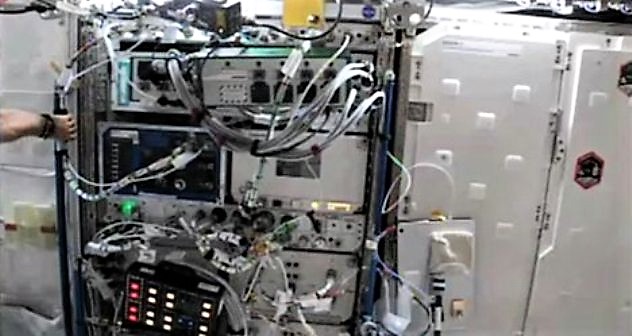By Oliver Peckham, WPC Wire
Summer 2019 – After 615 days on the International Space Station (ISS), HP Enterprise’s Spaceborne Computer has returned to Earth. The computer touched down onboard the same SpaceX Dragon capsule that brought it to the ISS in August 2017 – a far cry from initial predictions that it would fail within a week and be returned with the trash. Now, with Spaceborne “1” on the ground, HPE and NASA are preparing to assess the returned system – and planning for Spaceborne 2.
The mission
The one-teraflops (per Linpack testing) Spaceborne Computer was sent to the ISS to investigate the long-term supercomputing capabilities of an “off-the shelf” system in space – namely, its resilience in the face of strong gravitational forces, regular radiation, galactic cosmic rays, and the occasional case of human error. “There were many naysayers who said that modern technology could not handle the hazards of space travel – the radiation would destroy the hardware, et cetera,” said Dr. Mark Fernandez, Americas HPC Technology Officer at HPE, in an interview with HPCwire.
The computer encountered a variety of anomalies, ranging from temperature anomalies to higher rates of processor cache errors to an astronaut’s knee bumping into the emergency power switch and causing a hard crash. This barrage of challenges – which Dr. Fernandez calls “exciting for us” – was exactly what the team wanted.
“If the rate [of errors] is higher and you’re still able to contain them and still able to continue working, then that’s a good thing,” said Dr. Fernandez. “And we were able to do that.”
The methods
HPE didn’t make the Spaceborne Computer resilient by modifying the hardware – that would defeat the purpose of the test. Instead, HPE was able to push back against the dangers of space travel by using software hardening.
“We took a step back and said, ‘I don’t want to plan for radiation of this type at this intensity and guess about what it might affect,’” Dr. Fernandez explained. “We monitored all of the parameters that are naturally available on a modern computer system, and when they go outside of nominal range we have a stair step of actions we take that begins with ‘slow this down and alert somebody’ all the way down to ‘I’m going to shut down in order to save the hardware.’”
During those times when NASA knew that there would be high-intensity events, people on the ground closely monitored the system to see how the hardening performed. “For example, we had a pretty intensive solar flare event back in January or February,” Dr. Fernandez said. “So we closely monitored the system and how our software responded to it because we knew that was an interesting event.”
The software hardening performed well beyond initial expectations, and the system ran in the ISS for over a year, including a six-month extension by NASA that allowed HPE to begin testing outside software on the Spaceborne Computer.
The homecoming
With the Spaceborne Computer safely en route back to HPE, the company is ready to dissect the results. It will undergo a rigorous product failure analysis: four copies of each part that failed in space will be sent for inspection in a double-blind study – two copies that were in space and two copies from control systems kept on Earth.
The inspectors will be asked to determine whether each component still works and to use visual inspection and spectroscopy to ascertain its age. This process will help HPE and NASA diagnose what caused each component to fail and how long it would be able to survive on, for instance, a mission to Mars.
The future

The Spaceborne “1” Computer installed in the International Space Station
“There were so many people saying that this wouldn’t work that we put in as much redundancy as we could,” said Dr. Fernandez. “So I have two identical systems flying […] and that kind of limited what we could take up there. But now we’ve got the confidence that our hardening of software is working. We want to take a variety of computing systems up there next time.”
Fernandez is talking about Spaceborne 2. For Spaceborne 2, the team is hoping to bring along a series of different systems – one HPC-oriented, one aimed at machine learning and AI, and – possibly – additional hardware aimed at communications processing, which might make tasks like flying helicopters on Mars more manageable.
Spaceborne 2 will also seek to make the software hardening abilities of the supercomputer more intelligent using machine learning and AI. “We want it to keep track of and learn from the anomalies that it’s encountered,” said Fernandez. “Whether they bothered us or not, whether or not the action we took was helpful or not helpful, and then have it begin to take over what happens when we anticipate more anomalies.”
These new capabilities – and a better understanding of the durability of supercomputers in space – will put HPE and NASA a couple of steps closer toward supercomputers on the moon – and, eventually, Mars.